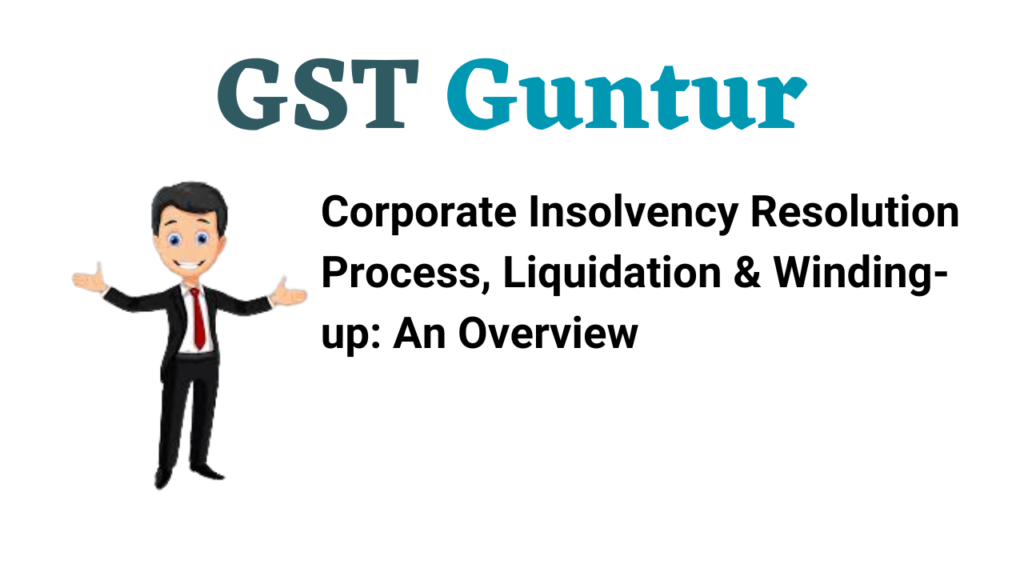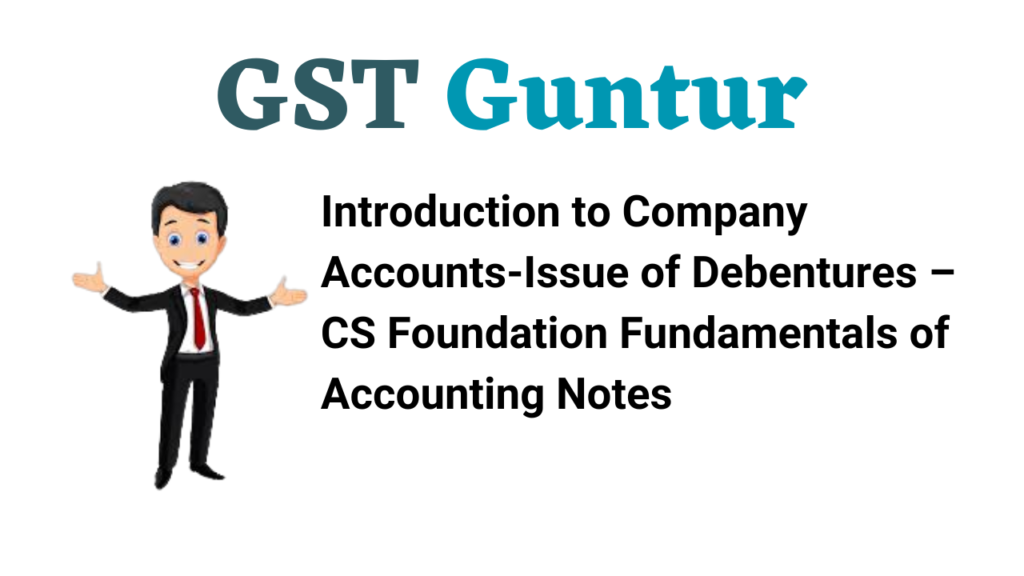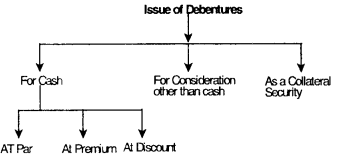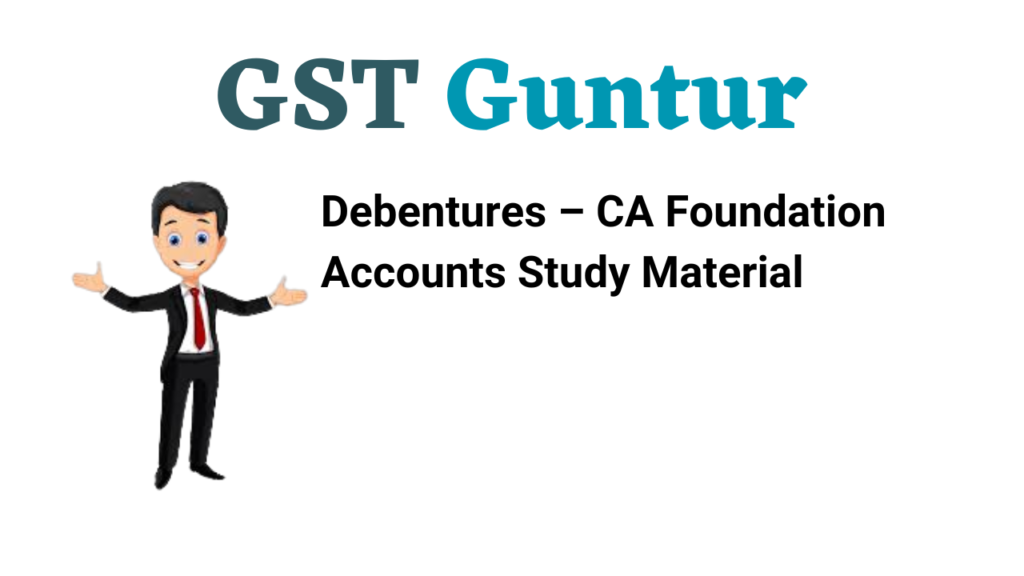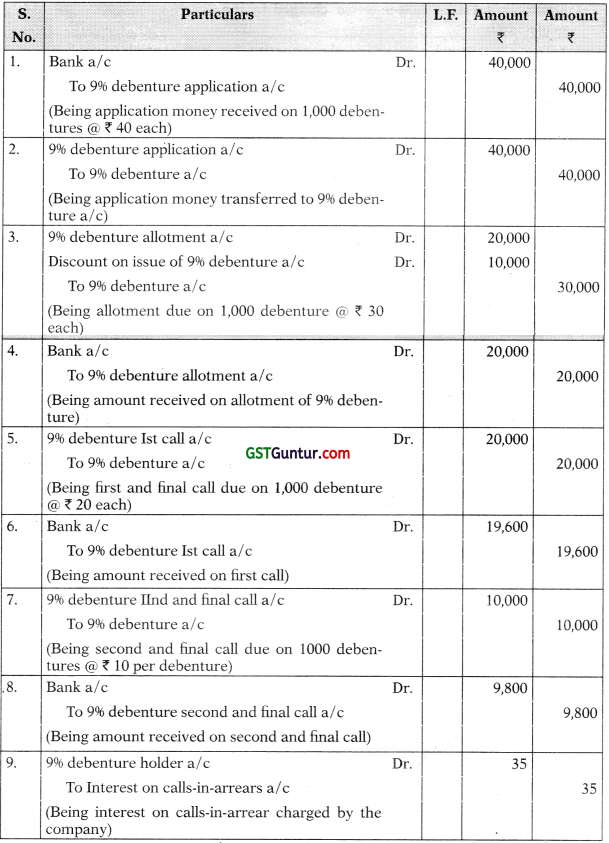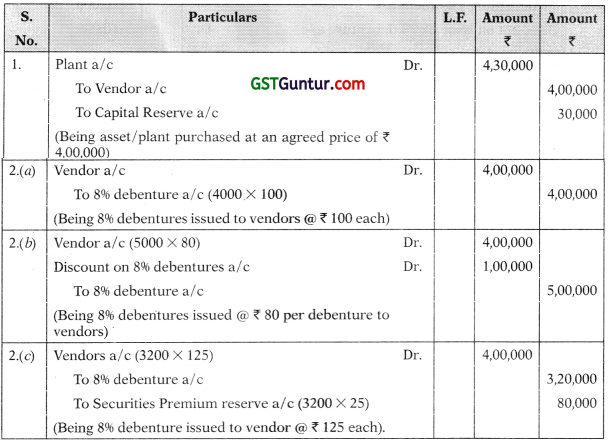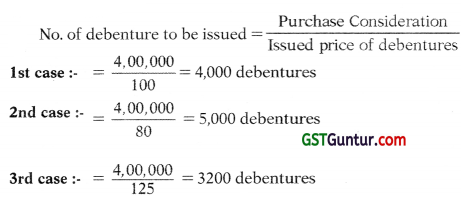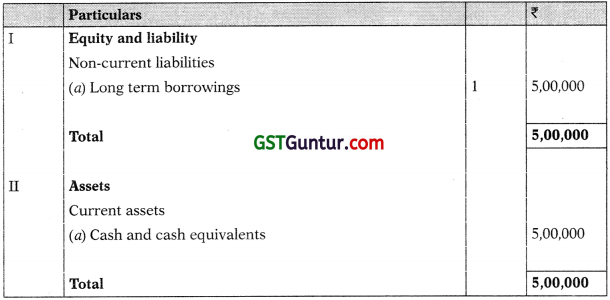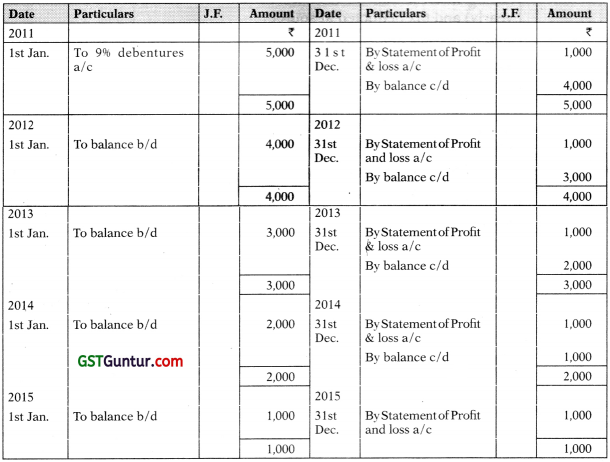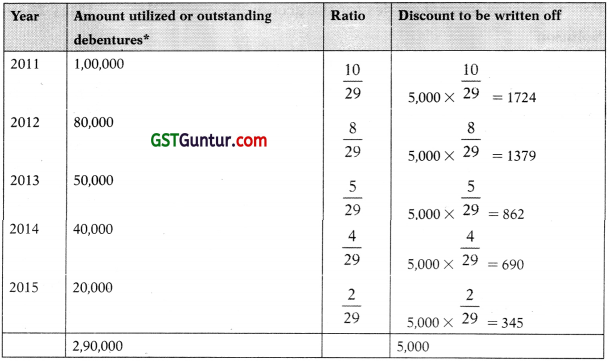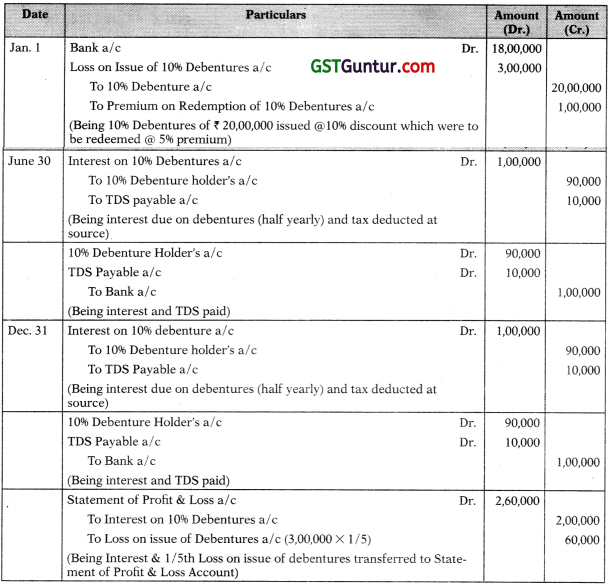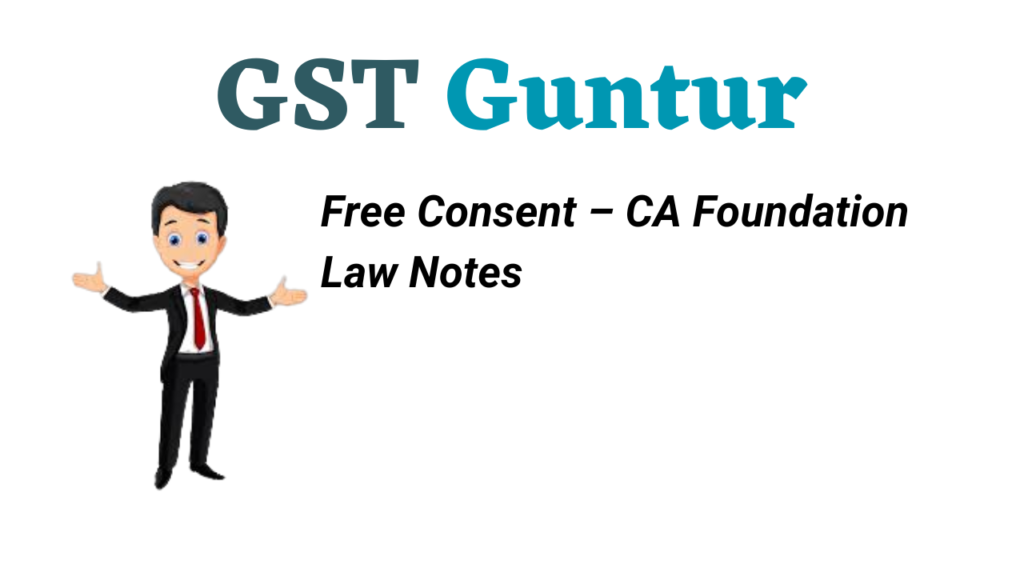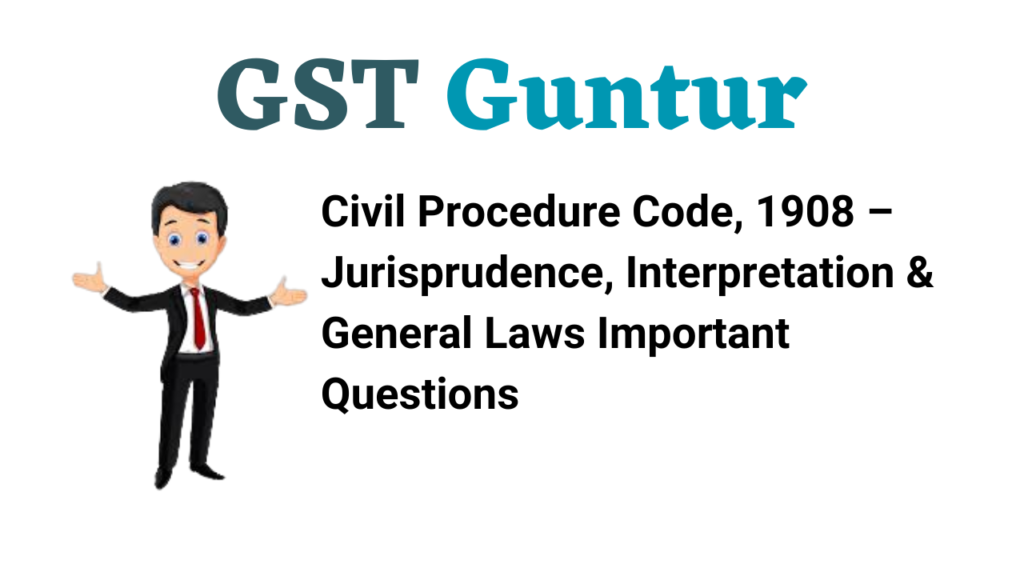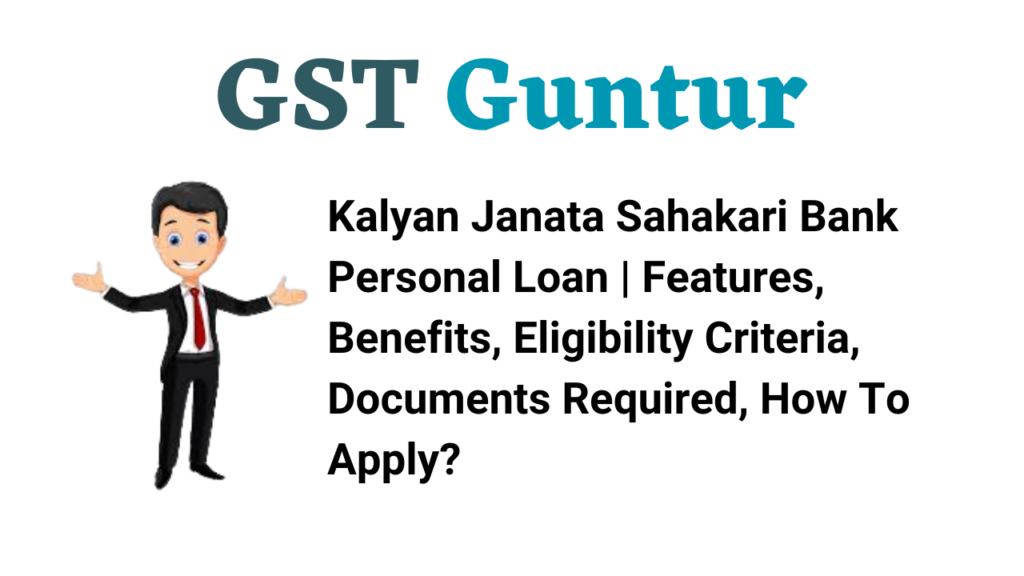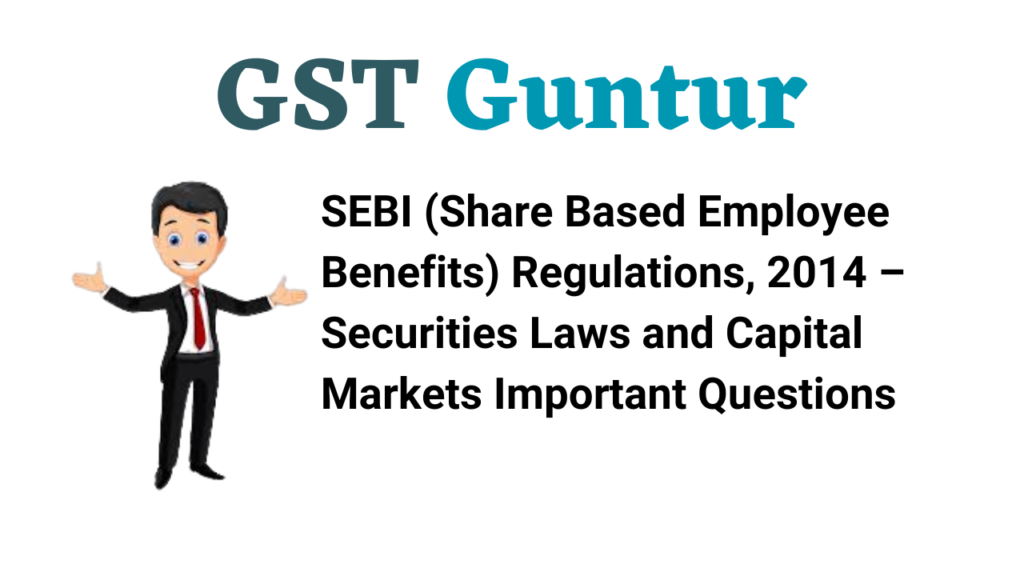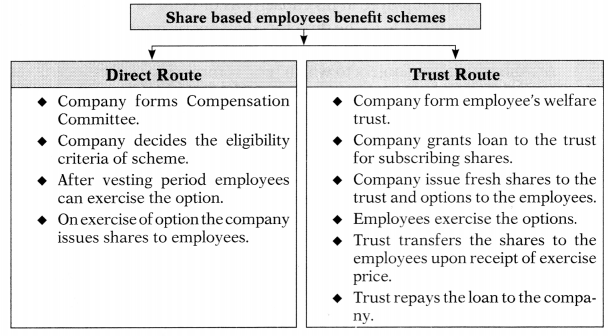SEBI (Substantial Acquisition of Shares & Takeovers) Regulations, 2011 – Securities Laws and Capital Markets Important Questions
Question 1.
What do you understand by ‘Takeover’?
Answer:
The takeover means purchasing shares of the company with a view to take over management and control of a company. This is also called ‘Corporate Raid’ and the persona taking over is called ‘Corporate Raiders’.
Acquirer: A person who acquires shares directly or indirectly is called an acquirer. Target Company: The listed company whose shares are being acquired is called the target company.
Takeover: When the acquirer takes over control or management of the target company, it is termed as a takeover.
The takeover is an inorganic corporate growth device whereby one company acquires control over another company, usually by purchasing all or a majority of its shares.
The takeover of management and control of a company could take place in different modes. The management of a company may be acquired by acquiring the majority stake in the share capital of a company. A company may acquire shares of an unlisted company through what is called the acquisition under Sections 235 & 236 of the Companies Act, 2013. Where the shares of the company are closely held by a small number of persons, a takeover may be effected by agreement with the holders of those shares. However, where the shares of a company are widely held by the general public, it involves the process as set out in the SEBI (Substantial Acquisition of Shares & Takeovers) Regulations, 2011.
Question 2.
Discuss briefly the regulatory framework governing the ‘Takeovers’ in India.
Answer:
The legislation/regulations that mainly govern takeovers are as under:
- SEBI (Substantial Acquisition of Shares & Takeovers) Regulations, 2011.
- Companies Act, 2013.
- SEBI (Listing Obligations & Disclosure Requirements) Regulations, 2015. SEBI (Substantial Acquisition of Shares & Takeovers) Regulations, 2011 lays down the procedure to be followed by an acquirer for acquiring majority shares or controlling interest in another company.
As far as the Companies Act, 2013 is concerned; the provisions of Section 186 apply to the acquisition of shares through a Company. Sections 235 & 236 of the Companies Act, 2013 lays down legal requirements for purpose of the takeover of an unlisted company through the transfer of undertaking to another company.
As per Regulation 31 A(8) of the SEBI (Listing Obligations & Disclosure Requirements) Regulations, 2015, if any public shareholder seeks to re-classify itself as a promoter, such a public shareholder shall be required to make an open offer in accordance with the provisions of the SEBI (Substantial Acquisition of Shares & Takeovers) Regulations, 2011.
Question 3.
Briefly discuss provisions relating to compulsory acquisition of shares of minority shareholders. [Dec. 2015 (3 Marks)]
Answer:
The scheme may contain a proposal for the transfer of shares from Transferor Company to Transferee Company. If the proposal from the Transferee Company is approved by holders of 90% of shares of Transferor Company, the Transferee Company can compulsorily acquire shares of Transferor Company (who will be less than 10%). This provision has been made to ensure that minority shareholders do not block the sale when substantially majority has accepted the scheme. While calculating 90% shares, the shares already held by the Transferee Company or its nominee on the date of the offer will be excluded.
Reconstruction by the sale of shares: Reconstruction or amalgamation without NCLT procedure is possible u/s 235 by a takeover by the sale of shares. Selling shareholders get either compensation or shares of acquiring company. This procedure is rarely followed, as a sanction of shareholders holding 90% of the value of shares is required. This is difficult to obtain. Further, the route provided in Section 235 can be followed when creditors are not involved in reconstruction and their interests are not affected. Thus, these provisions are useful to acquire a small company or closely held company or where a holding company already holds 90% or more and wants to convert a subsidiary company into a wholly-owned subsidiary.
Power to acquire shares of shareholders dissenting from scheme or contract approved by the majority [Section 235]: Where a scheme or contract involving the transfer of shares or any class of shares in transferor company to transferee company approved by the holders of not less than 9/ 10th in value of the shares then transferee company may give notice to any dissenting shareholder that it desires to acquire his shares. While calculating 9/ 10th in value of the shares already held at the date of the offer by, or by a nominee of the transferee company or its subsidiary companies will be excluded.
Students should note that the approval of shareholders holding 90% of the value of shares is required and not 90% of the value of shareholders attending the meeting.
The offer shall remain open for a period of 4 months. Thus, any shareholder of the transferor company may agree to transfer his shares to the transferee company within a period of 4 months from the date of the offer.
Notice to any dissenting shareholder may be given by the transferee company within 2 months of the expiry of a period of 4 months during which the offer was open. Such notice has to be given in Form No. CAA-14.
“Dissenting shareholder” includes a shareholder who has not assented to the scheme or contract and any shareholder who has failed or refused to transfer his shares to the transferee company in accordance with the scheme or contract.
Right of a dissenting shareholder to make an application to the Tribunal: A dissenting shareholder may make an application within 1 month of receipt of notice to the Tribunal praying that acquisition of his shares should not be permitted.
However, if no such application is made by dissenting shareholders or application is rejected by the Tribunal then the transferee company shall be entitled to and bound to acquire those shares on the same terms on which shares of approving shareholders were transferred to the transferee company.
Procedure for acquiring shares by transferee company: The transferee company shall on the expiry of 1 month from the date on which the notice has been given, send a copy of the notice to the transferor company together with an instrument of transfer.
The instrument of transfer shall be executed:
(a) on behalf of the dissenting shareholder, by some person appointed by the transferor company and
(b) on behalf of the transferee company, by a person authorized by the transferee company.
The transferee company shall pay the consideration to the transferor company for acquiring shares of dissenting shareholders.
The transferor company shall:
(a) thereupon register the transferee company as the holder of those shares; and
(b) within 1 month of the date of such registration, inform the dissenting shareholders of the fact of such registration and of the receipt of the amount or other consideration representing the price payable to them by the transferee company.
Amount of consideration must be paid within 60 days to dissenting share-holders: Any sum received by the transferor company shall be paid into a separate bank account, and any such sum and any other consideration so received shall be held by the transferor company in trust for dissenting shareholders and shall be disbursed the consideration to the dissenting shareholders within 60 days.
Registration of Offer of Schemes involving the transfer of shares [Section 238]: In relation to every offer of a scheme or contract involving the transfer of shares or any class of shares in the transferor company to the transferee company j u/s 235
- Every circular containing such offer and recommendation to the members of the transferor company by its directors to accept such offer shall be accompanied by such information as set out in Form No. CAA-15.
- Every such offer shall contain a statement by or on behalf of the transferee company, disclosing the steps it has taken to ensure that necessary cash will be available.
- Every such circular shall be presented to the ROC for registration and no such circular shall be issued until it is so registered.
However, the ROC may refuse, for reasons to be recorded in writing, to register any such circular which does not contain the required information or which sets out such information in a manner likely to give a false impression and communicate such refusal to the parties within 30 days of the application.
An appeal shall lie to the Tribunal against an order of the ROC refusing to register any such circular and the said appeal shall be in Form No. NCLT-9 supported with an affidavit in Form No. NCLT-6.
The director who issues a circular which has not been presented for registration and registered shall be punishable with a line which shall not be less than ₹ 25,000 but which may extend to ₹ 5 lakh.
Question 4.
What disclosures are required to be made by an acquirer while acquiring the shares of another company? [Dec. 2013 (5 Marks)]
Answer:
The obligation to give the disclosures on the acquisition of certain limits | is only on the acquirer and not on the target company. Following disclosures j are required to be made:
| Triggering Point |
To and by whom |
Time Period |
| Event-Based Disclosures |
| Acquisition of 5% or more shares or voting rights |
To the Target Company and Stock Exchange by the Acquirer |
Within 2 working days of:
(a) Receipt of intimation of allotment of shares or
(b) The acquisition of shares or voting rights. |
| Acquirer already holding 5% or more shares or voting rights On acquisition or disposal of 2% or more shares or voting rights. |
To the Target Company and Stock Exchange by the Acquirer/Seller |
Within 2 working days of such acquisition/disposal. |
| Continual Disclosures |
| Any person holding 25% or more shares or voting rights |
Target Company & Stock Exchange by such person |
Within 7 working days from the end of each financial year |
| Promoter/Person having control over the Target Company |
Target Company & Stock Exchange by Promoter |
Within 7 working days from the end of each financial year |
| Disclosure of Pledged or Encumbered Shares |
| On the encumbrance of shares by the promoter or person acting in Concert with him |
Target Company & Stock Exchange by the promote |
Within 7 working days from the date of creation of encumbrance. |
| On the invocation of or release of such encumbrance by the promoter |
Target Company & Stock Exchange by the promoter |
Within 7 working days from the date of invocation of encumbrance. |
Question 5.
Write a short note on Conditional Offer [Dec. 2014 (4 Marks)]
Answer:
An offer in which the acquirer has stipulated a minimum level of acceptance is known as a conditional offer.
Conditional offer [Regulation 19]: An acquirer may make an open offer conditional as to the minimum level of acceptance. However, where the open offer is pursuant to an agreement, such agreement shall contain a condition to the effect that in the event the desired level of acceptance of the open offer is not received the acquirer shall not acquire any shares under the open offer and the agreement attracting the obligation to make the open offer shall stand rescinded.
Where an open offer is made conditional upon minimum level of acceptances, the acquirer and persons acting in concert with him shall not acquire, during the offer period, any shares in the target company except under the open offer and any underlying agreement for the sale of shares of the target company pursuant to which the open offer is made.
Question 6.
The disclosure requirements on the acquisition of shares of a listed target company beyond certain limits are only on the acquirer and not on the target company. [June 2015 (4 Marks)]
Answer:
The obligation to give the disclosures on the acquisition of certain limits is only on the acquirer and not on the target company. Following disclosures j are required to be made:
| Triggering Point |
To and by whom |
Time Period |
| Event-Based Disclosures |
| Acquisition of 5% or more shares or voting rights |
To the Target Company and Stock Exchange by the Acquirer |
Within 2 working days of:
(a) Receipt of intimation of allotment of shares or
(b) The acquisition of shares or voting rights. |
| Acquirer already holding 5% or more shares or voting rights On acquisition or disposal of 2% or more shares or voting rights. |
To the Target Company and Stock Exchange by the Acquirer/Seller |
Within 2 working days of such acquisition/disposal. |
| Continual Disclosures |
| Any person holding 25% or more shares or voting rights |
Target Company & Stock Exchange by such person |
Within 7 working days from the end of each financial year |
| Promoter/Person having control over the Target Company |
Target Company & Stock Exchange by Promoter |
Within 7 working days from the end of each financial year |
| Disclosure of Pledged or Encumbered Shares |
| On the encumbrance of shares by the promoter or person acting in Concert with him |
Target Company & Stock Exchange by the promote |
Within 7 working days from the date of creation of encumbrance. |
| On the invocation of or release of such encumbrance by the promoter |
Target Company & Stock Exchange by the promoter |
Within 7 working days from the date of invocation of encumbrance. |
Question 7.
Write a short note on the Escrow account [Dec. 2015 (4 Marks)]
Answer:
Escrow Account [Regulation 17]: Escrow Account means a bank account that is required to be opened by an acquirer who proposes to make a public announcement of an open offer. The Regulations have made detailed provisions regarding the Escrow Account.
Regulation 17(1) provides that not later than 2 working days prior to the date of the publication of the detailed public statement of an open offer for acquiring shares, the acquirer shall create an escrow account towards security for performance of his obligations and deposit in such escrow account specified amount.
The purpose of these provisions is to ensure that the acquirer has sufficient funds to pay the consideration under the offer and he has secured sufficient financial arrangement.
Timing of opening of account: The Acquirer shall open an escrow account at least 2 working days prior to the date of Detailed Public Statement.
Amount to be deposited:
| The consideration payable under the Open Offer |
Amount to be deposited in Escrow Account |
| On the first ₹ 500 Crore |
An amount equal to 25% of the consideration |
| On the balance consideration |
An additional amount equal to 10% of the balance consideration |
Where an open offer is made conditional upon minimum level of acceptance, 100% of the consideration payable in respect of the minimum level of acceptance or 50% of the consideration payable under the open offer, whichever is higher, shall be deposited in cash in the escrow account.
In the case of indirect acquisitions where a public announcement has been made, an amount equivalent to 100% of the consideration payable in the open offer shall be deposited in the escrow account.
Increase in the amount of escrow [Regulation 17(2)]: If the Acquirer makes any upward revision in the open offer, whether by way of increase in offer price or of the offered size, then the Acquirer shall make corresponding increases to the amount kept in an escrow account prior to making such revision.
Mode of Deposit in Escrow Account [Regulation 17(3)]: The escrow account referred to above may be in the form of –
(a) Cash deposited with any scheduled commercial bank;
(b) Bank guarantee issued in favor of the manager to the open offer by any scheduled commercial bank; or
(c) Deposit of frequently traded and freely transferable equity shares or other freely transferable securities with appropriate margin.
Deposit of securities shall not be permitted in respect of indirect acquisitions.
Question 8.
Kind Enterprises Ltd. has decided to acquire a stake of up to 25% of the paid-up share capital of Excel Exams Ltd., which is a listed company and wants to proceed with a public offer pursuant to the provisions of the SEBI (Substantial Acquisition of Shares & Takeovers) Regulations, 2011. Prepare a Board note highlighting the general obligations of Kind Enterprises Ltd. [June 2015 (10 Marks)]
Answer:
Obligations of the acquirer [Regulation 25]:
1. Prior to making the public announcement of an open offer for acquiring shares, the acquirer shall ensure that firm financial arrangements have been made for fulfilling the payment obligations and that the acquirer is able to implement the open offer, subject to any statutory approvals for the open offer that may be necessary.
2. In the event the acquirer has not declared an intention in the detailed public statement and the letter of offer to alienate any material assets of the target company or of any of its subsidiaries whether by way of sale, lease, encumbrance, or otherwise outside the ordinary course of business, the acquirer, where he has acquired control over the target company, shall be debarred from causing such alienation for a period of 2 years after the offer period.
However, in the event the target company or any of its subsidiaries is required to alienate assets despite the intention to alienate not having been expressed by the acquirer, such alienation shall require a special resolution passed by shareholders of the target company, by way of a postal ballot and the notice for such postal ballot shall inter alia contain reasons as to why such alienation is necessary.
3. The acquirer shall ensure that the contents of the public announcement, the detailed public statement, the letter of offer, and the post-offer advertisement are true, fair, and adequate in all material aspects and not misleading in any material particular, and are based on reliable sources, and state the source wherever necessary.
4. The acquirer and persons acting in concert with him shall not sell shares of the target company held by them, during the offer period.
5. The acquirer and persons acting in concert with him shall be jointly and severally responsible for the fulfillment of applicable obligations under the regulations.
Question 9.
Write short note on Acquirer [Dec. 2016 (3 Marks)]
Answer:
“Acquirer” means any person who, directly or indirectly, acquires or agrees to acquire whether by himself, or through, or with persons acting in concert with him, shares or voting rights in, or control over a target company.
In simple words, a person who acquires shares/voting rights/control directly or indirectly of the target company with persons acting in concert is called ‘Acquirer’.
Persons acting in concert [Regulation 2(q)]: Persons acting in concert means –
1. Persons who, with a common objective or purpose of acquisition of shares or voting rights in, or exercising control over a target company, pursuant to an agreement or understanding, formal or informal, directly or indirectly co-operate for the acquisition of shares or voting rights in, or exercise of control over the target company.
2. The persons falling within the following categories shall be deemed to be persons acting in concert with other persons within the same category unless the contrary is established:
- A company, its holding company, subsidiary company, and any company under the same management or control;
- A company, its directors, and any person entrusted with the management of the company;
- Directors of companies referred to in clauses (1) and (2) and associates of such directors;
- Promoters and members of the promoter group;
- Immediate relatives;
- A mutual fund, its sponsor, trustees, trustee company, and asset management company;
- A collective investment scheme and its collective investment management company, trustees and trustee company;
- A venture capital fund and its sponsor, trustees, trustee company, and asset management company;
- an alternative investment fund and its sponsor, trustees, trustee company, and manager;
- [Deleted]
- A merchant banker and its client, who is an acquirer;
- A portfolio manager and its client, who is an acquirer;
- Banks, financial advisors, and stockbrokers of the acquirer, or of any company which is a holding company or subsidiary of the acquirer, and where the acquirer is an individual, of the immediate relative of such individual. However, this clause shall not apply to a bank whose sole role is that of providing normal commercial banking services or activities in relation to an open offer under these regulations;
- An investment company or fund and any person who has an interest in such investment company or fund as a shareholder or unit holder having not less than 10% of the paid-up capital of the investment company or unit capital of the fund, and any other investment company or fund in which such person or his associate holds not less than 10% of the paid-up capital of that investment company or unit capital of that fund. However, nothing contained in this clause shall apply to the holding of units of mutual funds registered with the SEBI.
Explanation: “Associate” of a person means –
(a) Any immediate relative of such person;
(b) Trusts of which such person or his immediate relative is a trustee;
(c) Partnership firm in which such person or his immediate relative is a partner; and
(d) Members of Hindu undivided families of which such person is a coparcener.
Question 10.
Regulation 10 of the Takeover Code provides an automatic exemption from the applicability of making open offers. [Dec. 2016 (2 Marks)]
Answer:
Regulation 10 of the SEBI Takeover Regulations, 2011 provides for automatic exemptions from the applicability of making Open Offer to the shareholders of the Target Company in respect of certain acquisitions subject to the compliance of certain conditions specified therein.
Further Regulation 11 of SEBI Takeover Regulations, 2011 provides the provisions whereby the acquirer can apply to SEBI for availing the exemption from the Open Offer obligations and the Target Company can apply for relaxation from strict compliance with any procedural requirement relating to Open Offer as provided under Chapters III and IV of the Regulations.
Some of the exemptions provided in Regulation 10 along with their conditions for exemption are as follows:
Acquisition pursuant to inter .se transfer of shares amongst qualifying persons, being,:
- immediate relatives;
- persons named as promoters in the shareholding pattern filed by the target company in terms of the listing regulations or these regulations for not less than three years prior to the proposed acquisition;
- a company, its subsidiaries, its holding company, other subsidiaries of such – holding company, persons holding not less than 50% of the equity shares of such company, other companies in which such persons hold not less than 50% of the equity shares, and their subsidiaries subject to control over such qualifying persons being exclusively held by the same persons;
- persons acting in concert for not less than 3 years prior to the proposed acquisition and disclosed as such pursuant to filings under the listing regulations.
Note: The list of exemptions provided in Regulation 10 is much more; considering the marks of the question only some of the clauses are given.
Question 11.
A competitive bid is an offer made by a person other than the acquirer who has made the first public announcement. [Dec. 2016 (2 Marks)]
Answer:
A competitive bid is an offer made by a person, other than the acquirer who has made the first public announcement.
A public announcement is an announcement made in the newspapers by the acquirer primarily disclosing his intention to acquire shares of the target company from existing shareholders by means of an open offer.
Switching of acceptances between different offers is possible. The shareholder has the option to withdraw acceptance tendered by him up to 3 working days prior to the date of closure of the offer.
To enable the shareholders to be in a better position to decide as to which of the subsisting offers is better and also not to cause last-minute decisions/ confusions, the offer price and size are effectively frozen for the last 7 working days prior to the closing date of the offers. Shareholders may wait till the commencement of that period to be aware of upward revisions in the offer price and size of the offers.
Question 12.
Write a short note on: Creeping acquisition limit [June 2017 (4 Marks)]
Answer:
Creeping acquisition limit: An acquirer who holds 25% or more but less than maximum permissible non-public shareholding of the Target Company, can acquire such additional shares as would entitle him to exercise more than 5% of the voting rights in any financial year ending March 31 only after making a Public Announcement to acquire minimum 26% shares of Target Company j from the shareholders through an Open Offer.
Question 13.
Explain the Modes of Payment to the shareholders of the Target Company on the acquisition of shares hy the acquirer under SEBI (Substantial Acquisition of Shares & Takeovers) Regulations, 2011. [June 2019 (4 Marks)]
Answer:
As per Regulation 9(1) of the SEBI (Substantial Acquisition of Shares & Takeovers) Regulations, 2011, the offer price may be paid:
(a) in cash;
(b) by issue, exchange, or transfer of listed shares in the equity share capital of the acquirer or of any person acting in concert;
(c) by issue, exchange, or transfer of listed secured debt instruments issued by the acquirer or any person acting in concert with a rating not inferior to investment grade as rated by a credit rating agency registered with the SEBI;
(d) by issue, exchange, or transfer of convertible debt securities entitling the holder thereof to acquire listed shares in the equity share capital of the acquirer or of any person acting in concert; or
(e) a combination of the mode of payment of consideration stated in clauses (a) to (d).
Question 14.
An acquirer, holding 25% or more but less than maximum permissible non-public shareholding of the Target Company can acquire such additional shares as would entitle him to exercise more than 5% of the voting rights in any financial year. Explain the statement indicating the creeping acquisition limit for making an open offer by an acquirer. [June 2019 (4 Marks)]
Answer:
Acquisition of more than 5% shares or voting rights in a financial year [Creeping Acquisition]: An acquirer along with PACs holds 25% or more but less than the maximum permissible non-public shareholding in a target company,
can acquire additional shares in the target company as would entitle him to exercise more than 5% of the voting rights in any financial year beginning April 1, only after making a public announcement of making an open offer to acquire the shares.
Note: Students should note that Takeover Regulations do not apply to acquisition up to 5% of shares per financial year – called ‘creeping acquisition’ till the acquirer reaches a stake of 7596. This is permissible to those whose holding is more than 25% but less than 75%. Such acquisition may be direct or indirect
Suppose the target company had 1,00,000 shares. The acquirer is already holding 31,000 shares and he intends to acquire further 5,000 shares per financial year, he can do so and Takeover Regulations will not be applicable. However, if he wants to acquire 5,001 shares then Takeover Regulations will be applicable and before acquiring such 5,001 shares he will have to make an open offer.
Question 15.
An unlisted public company (“Acquirer”) doing business of exporting steel and is a part of the Promoter Group of Maurya Hotels (India) Ltd. (MHIL), a company listed on the stock exchange. In view of improving its efficiency, MHIL is planning to restructure its group. The Acquirer has agreed to enter into a scheme of arrangement where the shares held by the promoter group companies (eight companies) will be transferred to it. Post-merger, the shareholding of the Acquirer in the Company will increase from 2% to 24%. However, the overall promoter shareholding will remain unchanged. You, being practicing company secretary, appointed as a consultant by the Acquirer, answer the following:
(i) Will the transfer of shares trigger an obligation to make an open offer under the SEBI (SAST) Regulations on the Acquirer?
(ii) What are the disclosure requirements under the SAST Regulations, if any, that the parties to the scheme will have to comply with? [June 2019 (5 Marks)]
Answer:
Acquisition of 25% or more shares or voting rights: An acquirer, who along with PACs holds less than 25% shares or voting rights in a target company and agrees to acquire shares or acquires shares which would entitle him to exercise 25% or more or voting rights in a target company, will need to make a public announcement of making an open offer to acquire the shares before acquiring such additional shares.
As per Regulation 10 of the SEBI (Substantial Acquisition of Shares & Takeovers) Regulations, 2011, acquisitions shall be exempt from the obligation to make an open offer under Regulation 3 when their acquisition pursuant to inter .se transfer of shares amongst qualifying persons, being persons named as promoters in the shareholding pattern filed by the target company in terms of the listing regulations or Takeover Regulations for not less than 3 years prior to the proposed acquisition.
As per facts given in the case, an unlisted public company (acquirer) proposes to increase its holding 2% to 24% by acquiring the shares of other promoters, which do not trigger provisions of obligation to make an open offer in terms of Regulation 3 read with Regulation 10 of the Takeover Regulations.
Disclosure: The Acquirer and promoter group companies will be required to make a disclosure of change in shareholding under Regulation 29(2) of the Takeover Regulations. According to Regulation 29(3), the disclosure should be made within 2 working days of such acquisition to the Company at its registered office and to stock exchanges where the shares of the Company are listed.
Note: Students should note that when the acquirer agrees to acquire 25% or more shares or voting rights in a target company he has to make an open offer to acquire further 26% shares of the target company. [Regulation 3 read with Regulation 7]
Suppose the target company had 1,00,000 shares. The acquirer is already holding 21,000 shares and he intends to acquire further 4,000 shares, he cannot acquire further 4,000 shares unless he makes an open offer to acquire another 26,000 shares from the public.
The reason for a stipulation to offer to purchase 26% shares from the public is that shareholders who may not approve the new management should have a chance to get out of his investment in the company at a fair price. The offer is restricted to 26% as if many shareholders offer to sell the shares, the acquirer may not have enough financial strength to purchase all shares offered.
Question 16.
Draft a suitable Board resolution with respect to takeover for the following:
(i) Offer by offeror company and
(ii) Authorization to invest in the shares of investee company [June 2011 (4 Marks)]
Answer:
Offer by Offeror Company:
“Resolved That an offer be made, to the persons who are the members of___________ Ltd. as on___________for acquisition of___________equity shares of ₹ 10 each representing a___________% of the total issued capital of the___________Ltd.
Resolved Further That above said offer shall remain open till___________at a price of ₹___________each.
Resolved Further That shares be accepted even if such shares in the aggregate are less than the limit mentioned above and in case shares offered to exceed the limit, the company shall have an option to accept or reject the same in consultation with the concerned authorities and offer will be accepted according to the order in which they are received and full shareholding of the members accepting the offer be acquired subject to an abovementioned limit.”
Authorization to invest in the shares of Investee Company:
“Resolved That pursuant to Section 186 and other applicable provisions if any, of the Companies Act, 2013 and authorization gave by the members of the company at their meeting held on___________unanimous consent of the Board of Directors be and is hereby given to invest up to equity shares of XYZ Ltd. at a price of ₹___________each.”
Question 17.
Sharad who is a promoter of Grow Good Ltd. holds 20% of the paid-up share capital of the company. The shares of the company are listed on National Stock Exchange Ltd. Sharad would like to pledge his shares for obtaining a loan. State the requirements for disclosure of pledged shares under the SEBI (Substantial Acquisition of Shares & Takeovers) Regulations, 2011. [June 2011 (8 Marks)]
Answer:
Disclosure of encumbered shares [Regulation 31]:
- The promoter of every target company shall disclose details of shares in such target company encumbered by him or by persons acting in concert | with him in such form as may be specified.
- The promoter of every target company shall disclose details of any invocation of such encumbrance or release of such encumbrance of shares j in such form as may be specified.
- The required disclosures shall be made within 7 working days from the creation or invocation or release of encumbrance, as the case may be to
(a) Every stock exchange where the shares of the target company are listed and
(b) The target company at its registered office.
Question 18.
Explain the provisions relating to ‘escrow account’ under the SEBI (Substantial Acquisition of Shares & Takeovers) Regulations, 2011. [June 2011 (7 Marks)]
Answer:
Escrow Account [Regulation 17]: Escrow Account means a bank ac- f count which is required to be opened by an acquirer who proposes to make a public announcement of an open offer. The Regulations have made detailed provisions regarding the Escrow Account.
Regulation 17(1) provides that not later than 2 working days prior to the date of the publication of the detailed public statement of an open offer for acquiring shares, the acquirer shall create an escrow account towards security for performance of his obligations and deposit in such escrow account specified amount.
The purpose of these provisions is to ensure that the acquirer has sufficient funds to pay tire consideration under the offer and he has secured sufficient financial arrangement.
Timing of opening of account: The Acquirer shall open an escrow account at least 2 working days prior to the date of Detailed Public Statement.
Amount to be deposited:
| The consideration payable under the Open Offer |
Amount to be deposited in Escrow Account |
| On the first ₹ 500 Crore |
An amount equal to 25% of the consideration |
| On the balance consideration |
An additional amount equal to 10% of the balance consideration |
Where an open offer is made conditional upon minimum level of acceptance, 100% of the consideration payable in respect of the minimum level of acceptance or 50% of the consideration payable under the open offer, whichever is higher, shall be deposited in cash in the escrow account.
In the case of indirect acquisitions where a public announcement has been made, an amount equivalent to 100% of the consideration payable in the open offer shall be deposited in the escrow account.
Increase in the amount of escrow [Regulation 17(2)]: If the Acquirer makes any upward revision in the open offer, whether by way of increase in offer price or of the offered size, then the Acquirer shall make corresponding increases to the amount kept in an escrow account prior to making such revision.
Mode of Deposit in Escrow Account [Regulation 17(3)]: The escrow account referred to above may be in the form of –
(a) Cash deposited with any scheduled commercial bank;
(b) Bank guarantee issued in favor of the manager to the open offer by any scheduled commercial bank; or
(c) Deposit of frequently traded and freely transferable equity shares or other freely transferable securities with appropriate margin.
Deposit of securities shall not be permitted in respect of indirect acquisitions.
Composition and other conditions of the escrow account [Regulation 17(4) to (7)]:
1. In the event of the escrow account is created by way of a bank guarantee or by deposit of securities, the acquirer shall also ensure that at least 1% of the total consideration payable is deposited in cash with a scheduled commercial bank as a part of the escrow account.
2. For such part of the escrow account as is in the form of a cash deposit with a scheduled commercial bank, the acquirer shall while opening the account, empower the manager to the open offer to instruct the bank to issue a banker’s cheque or demand draft or to make payment of the amounts lying to the credit of the escrow account, in accordance with requirements under these regulations.
3. For such part of the escrow account as is in the form of a bank guarantee, such bank guarantee shall be in favor of the manager to the open offer and shall be kept valid throughout the offer period and for an additional period of 30 days after completion of payment of consideration to shareholders who have tendered their shares in acceptance of the open offer.
4. For such part of the escrow account as is in the form of securities, the acquirer shall empower the Manager to the open offer to realize the value of such escrow account by sale or otherwise, and if there is any shortfall in the amount required to be maintained in the escrow account, the Manager shall be liable to make good such shortfall.
5. The Manager to the open offer shall not release the escrow account until the expiry of 30 days from the completion of payment of consideration to shareholders who have tendered their shares in acceptance of the open offer, save and except for the transfer of funds to the special escrow account.
6. In the event of non-fulfillment of obligations by the acquirer the SEBI may direct the Manager to forfeit the escrow account or any amounts lying in the special escrow account, either in full or in part.
7. The escrow account deposited with the bank in cash shall be released only in the following manner –
(a) The entire amount to the acquirer upon withdrawal of the offer. In the event the withdrawal is pursuant to Regulation 23(l)(c), the Manager to the open offer shall release the escrow account upon receipt of confirmation of such release from the SEBI;
(b) For transfer of an amount not exceeding 90% of the escrow account, to the special escrow account in accordance with Regulation 21.
(c) To the acquirer, the balance of the escrow account after transfer of cash to the special escrow account, on the expiry of 30 days from the completion of payment of consideration to shareholders who have tendered their shares in acceptance of the open offer, as certified by the manager to the open offer;
(d) The entire amount to the acquirer upon the expiry of 30 days from the completion of payment of consideration to shareholders who have tendered their shares in acceptance of the open offer, upon certification by the manager to the open offer, where the open offer is for exchange of shares or other secured instruments;
(e) The entire amount to the Manager, in the event of forfeiture for non-fulfillment of any of the obligations, for distribution in the following manner, after deduction of expenses of registered market intermediaries associated with the open offer:
- 1 /3rd of the escrow account to the target company;
- l/3rd of the escrow account to the Investor Protection & Education Fund established under the SEBI (Investor Protection & Education Fund) Regulations, 2009; and
- 1 /3rd of the escrow account to be distributed pro-rata among the shareholders who have accepted the open offer.
Question 19.
Draft a suitable Board resolution for the opening of an escrow account. [Dec. 2011 (4 Marks)]
Answer:
Board resolution for Opening of an Escrow Account:
Resolved That an Escrow Account be opened with Bank and ₹_________ be deposited in the said account.
Resolved Further That M/s_________Merchant Banker, be and is hereby authorized to operate the above-said account and the Bank be and is hereby authorized to act on the instructions given by M/s_________, Merchant Banker, in relation to the operation of a bank account.”
Resolved Further That Mr._________, Director of the company, be and is hereby authorized to collect and communicate the same to_________Bank, the names and specimen signatures of the person authorized by M/s._________, Merchant Banker, to operate the above-said bank account.”
Question 20.
Draft a suitable Board resolution for the appointment of a merchant banker by an acquirer under the SEBI (Substantial Acquisition of Shares & Takeovers) Regulation, 2011. [Dec. 2012 (5 Marks)]
Answer:
Board Resolution for the appointment of a Merchant Banker:
‘Resolved That M/s_________being Category-I Merchant Banker be and is hereby appointed as Merchant Banker for the aforesaid public offer, on the terms and conditions as contained in the draft letter of appointment placed before the meeting duly initialed by the Chairman for the purpose of identification, for making the public i ; announcement of the takeover offer in the newspapers, forward the same to the SEBI, Stock Exchange(s) and to the target company and to draft the Letter of Offer to be sent to the shareholders of_________, target company in accordance with the SEBI
(Substantial Acquisition of Shares & Takeover) Regulations, 2011”.
Question 21.
Explain ‘open offer thresholds’ under the SEBI (Substantial Acquisition of Shares & Takeovers) Regulations, 2011. [June 2013 (5 Marks)]
Answer:
Open offer thresholds [Regulation 3]: The following are the threshold g limits for the acquisition of shares/voting rights, beyond which an obligation to % make an open offer is triggered.
Acquisition of 25% or more shares or voting rights: An acquirer, who along with PACs holds less than 25% shares or voting rights in a target company and agrees to acquire shares or acquires shares which would entitle him to exercise 25% or more or voting rights in a target company, will need to make a public announcement of making an open offer to acquire the shares before acquiring such additional shares.
Note: Students should note that when the acquirer agrees to acquire 25% or more shares or voting rights in a target company he has to make an open offer to acquire further 26% shares of the target company. regulation 3 read with Regulation 7]
Suppose the target company had 1,00,000 shares. The acquirer is already holding 21,000 shares and he intends to acquire further 4,000 shares, he cannot acquire further 4,000 shares unless he makes an open offer to acquire another 26,000 shares from the public.
The reason for a stipulation to offer to purchase 26% shares from the public is that shareholders who may not approve the new management should have a chance to get out of his investment in the company at a fair price. The offer is restricted to 26% as if many shareholders offer to sell the shares, the acquirer may not have enough financial strength to purchase all shares offered.
Acquisition of more than 5% shares or voting rights in a financial year [Creeping Acquisition]: An acquirer along with PACs holds 25% or more but less than the maximum permissible non-public shareholding in a target company, can acquire additional shares in the target company as would entitle him to exercise more than 5% of the voting rights in any financial year beginning April 1, only after j making a public announcement of making an open offer to acquire the shares.
Note: Students should note that Takeover Regulations do not apply to acquisition up to 5% of shares per financial year – called ‘creeping acquisition’ till the acquirer reaches a stake of 75%. This is permissible to those whose holding is more than 25% but less than 75%. Such acquisition may be direct or indirect.
Suppose the target company had 1,00,000 shares. The acquirer is already holding 31,000 shares and he intends to acquire further 5,000 shares per financial year, he can do so and Takeover Regulations will not be applicable. However, if he wants to acquire 5,001 shares then Takeover Regulations will be applicable and before acquiring such 5,001 shares he will have to make an open offer.
Question 22.
What do you understand by ‘mandatory bid’ and when it is necessary? Describe briefly. [June 2013 (5 Marks)]
Answer:
A mandatory bid is a bid that is compulsorily required to be made as per the provisions of the SEBI (SAST) Regulations, 2011 where the acquirer intends to acquire shares or voting rights beyond threshold limits specified in Regulations 3, 4 & 5.
It is governed by Regulations 3, 4 & 5 of the SEBI (SAST) Regulations, 2011.
When mandatory bid can be made: The open offer for acquiring shares to be made by the acquirer and persons acting in concert with him shall be for at least 26% of total shares of the target company, as of 10th working day from the closure of the tendering period.
Question 23.
The SEBI (Substantial Acquisition of Shares & Takeovers) Regulations, 2011 provide some mechanism for automatic exemption from making ‘mandatory offer’ other than the inter .se transfer among the promoters. Briefly state four such situations. [June 2013 (4 Marks)]
Answer:
Exemptions from the open offer: Exemption maybe:
- Automatic Exemption [Regulation 10]
- Exemption by SEBI [Regulation 11]
Regulation 10 provides for automatic exemptions from the applicability of making an Open Offer to the shareholders of the Target Company in respect of certain acquisitions subject to the compliance of certain conditions specified therein.
As per Regulation 11, the SEBI may for reasons recorded in writing, grant exemption from the obligation to make an open offer for acquiring shares subject to such conditions as the SEBI deems fit to impose in the interests of investors in securities and the securities market.
The SEBI may for reasons recorded in writing, grant a relaxation from strict compliance with any procedural requirement subject to such conditions as the SEBI deems fit to impose in the interests of investors in securities and the I securities market.
Some situations where an automatic exemption applies:
- Acquisition pursuant to a resolution plan approved u/s 31 of the Insolvency and Bankruptcy Code, 2016.
- The acquisition is pursuant to the provisions of the Securitization and Reconstruction of Financial Assets and Enforcement of Security Interest Act, 2002.
- The acquisition is pursuant to the provisions of the SEBI (Delisting of Equity Shares) Regulations, 2009.
- Acquisition by way of transmission, succession, or inheritance.
- Acquisition of voting rights or preference shares carrying voting rights arising out of the operation of the Companies Act, 2013.
Question 24.
Mention the factors which make a company vulnerable to takeover bids. [Dec. 2014 (5 Marks)]
Answer:
Some of the factors which make a company vulnerable to takeover bids are as follows:
- Low stock price with relation to the replacement cost of assets or their potential earning power.
- A highly liquid balance sheet with large amounts of excess cash, a valuable securities portfolio, and significantly unused debt capacity.
- Good cash flow in relation to current stock prices.
- Subsidiaries and properties which could be sold off without significantly impairing cash flow.
- Relatively small stockholdings under the control of incumbent management.
A combination of these factors can simultaneously make a company an attractive proposition or investment opportunity and facilitate its financing.
Question 25.
What are the obligations of the committee of independent directors of the target company with regard to providing reasoned recommendations on the open offer being made by the acquirers? [Dec. 2014 (5 Marks)]
Answer:
As per Regulation 26(7), the committee of independent directors shall provide its written reasoned recommendations on the open offer to the shareholders of the target company and such recommendations shall be published in such form as may be specified, at least 2 working days before the commencement of the tendering period, in the same newspapers where the public announcement of the open offer was published, and simultaneously, a copy of the same shall be sent to –
- The SEBI;
- All the stock exchanges on which the shares of the target company are listed, and the stock exchanges shall forthwith disseminate such information to the public; and
- The manager to the open offer, and where there are competing offers, to the manager to the open offer for every competing offer.
Question 26.
Amilo Exports Ltd., a listed company has opened an escrow account in connection with acquiring another company. The company wants your opinion on the release of the amount from the escrow account. Comment. [Dec. 2014 (3 Marks)]
Answer:
As per Regulation 17 of the SEBI (Substantial Acquisition of Shares & Takeovers) Regulations, 2011, the escrow account deposited with the bank in cash shall be released only in the following manner:
(a) The entire amount to the acquirer upon withdrawal of the offer. In the event the withdrawal is pursuant to Regulation 23(l)(c), the Manager to the open offer shall release the escrow account upon receipt of confirmation of such release from the SEBI;
(b) For transfer of an amount not exceeding 9096 of the escrow account, to the special escrow account in accordance with Regulation 21.
(c) To the acquirer, the balance of the escrow account after transfer of cash to the special escrow account, on the expiry of 30 days from the completion of payment of consideration to shareholders who have tendered their shares in acceptance of the open offer, as certified by the manager to the open offer;
(d) The entire amount to the acquirer upon the expiry of 30 days from the completion of payment of consideration to shareholders who have tendered their shares in acceptance of the open offer, upon certification by the manager to the open offer, where the open offer is for exchange of shares or other secured instruments;
(e) The entire amount to the Manager, in the event of forfeiture for non-fulfillment of any of the obligations, for distribution in the following manner, after deduction of expenses of registered market intermediaries associated with the open offer:
- 1 /3rd of the escrow account to the target company;
- 1 /3rd of the escrow account to the Investor Protection & Education Fund established under the SEBI (Investor Protection & Education Fund) Regulations, 2009; and
- 1/3rd of the escrow account to be distributed pro-rata among the shareholders who have accepted the open offer.
Question 27.
In terms of the SEBI (Substantial Acquisition of Shares & Takeovers) Regulations, 2011, ‘offer period’ and ‘tendering period’ are one and the same. Comment. [June 2015 (3 Marks)]
Answer:
Offer period and tendering period: The term ‘offer period’ pertains to the period starting from the date of the event triggering open offer till completion of payment of consideration to shareholders by the acquirer or withdrawal of the offer by the acquirer as the case may be.
The term ‘tendering period’ refers to the 10 working days period falling within the offer period, during which the eligible shareholders who wish to accept the open offer can tender their shares in the open offer.
Tenure of tendering period [Regulation 18(8)]: The tendering period shall start not later than twelve working days from the date of receipt of comments from the SEBI under Regulation 16(4) and shall remain open for 10 working days.
Tendered shares shall not be withdrawn [Regulation 18(9)]: Shareholders who have tendered shares in acceptance of the open offer shall not be entitled to withdraw such acceptance during the tendering period.
Question 28.
The acquirer can opt-out of the open offer process at any point in time by informing the stock exchange wherein the shares of the target company are listed and furnishing a copy of the communication to the target company. Comment. [June 2015 (3 Marks)]
Answer:
In Nirma Industries Ltd. v. Securities & Exchange Board of India, the Supreme Court has held that an open offer for acquiring shares in Target Company once made cannot be withdrawn except in cases where it specifically allowed to withdraw under the SEBI (Substantial Acquisition of Shares & Takeovers) Regulations, 2011.
Thus, the acquirers should make a ‘Public Offer’ only after the most careful consideration and must ensure that it is able to implement the offer. Referring to Regulation 27, the Supreme Court observed that a public offer once made could not be withdrawn except in the circumstances provided in the said Regulation which had to be construed strictly.
Question 29.
Revision of offer price can be made by the acquirer upward but that can be exercised only in the event of there being a competing offer. Comment. [June 2015 (3 Marks)]
Answer:
Revision of offer price [Regulation 18(4) & (5)]: Irrespective of whether a competing offer has been made, an acquirer may make upward revisions to the offer price, to the number of shares sought to be acquired under the open offer, at any time prior to the commencement of the last 1 working day before the commencement of the tendering period.
In the event of any revision of the open offer, whether by way of an upward revision in offer price or of the offered size, the acquirer shall:
(a) make corresponding increases to the amount kept in an escrow account prior to such revision;
(b) make an announcement in respect of such revisions in all the newspapers in which the detailed public statement pursuant to the public announcement was made; and
(c) simultaneously with the issue of such an announcement, inform the SEBI, all the stock exchanges on which the shares of the target company are listed, and the target company at its registered office.
Question 30.
The acquisition of shares resulting from invocation of pledges by a public financial institution is exempt from open offer obligation. Comment. [June 2015 (3 Marks)]
Answer:
Regulation 10 of the SEBI (Substantial Acquisition of Shares and Take-overs) Regulations, 2011 provides for automatic exemptions from the applicability of making Open Offer to the shareholders of the Target Company in respect of certain acquisitions subject to the compliance of certain conditions specified therein.
As per Regulation 10, acquisition in the ordinary course of business by Invocation of pledge by Scheduled Commercial Banks or Public Financial Institutions as a pledgee is covered in general exemption and hence given statement is correct.
Question 31.
How is the open offer price for the acquisition of shares of a listed target company whose shares are frequently traded determined? [June 2015 (5 Marks)]
Answer:
Offer Price [Regulation 8(1)]: The open offer for acquiring shares under Regulation 3, 4, 5, or 6 shall be made at a price not lower than the price determined in accordance with Regulation 8(2) or (3).
Determination of offer price – direct acquisition [Regulation 8(2)]: In the case of direct acquisition of shares or voting rights in, or control over the target company, and indirect acquisition of shares or voting rights in, or control over the target company where the parameters referred to in Regulation 5(2) are met, the offer price shall be the highest of –
(a) The highest negotiated price per share of the target company for any acquisition under the agreement attracting the obligation to make a public announcement of an open offer.
(b) The volume-weighted average price paid or payable for acquisitions, whether by the acquirer or by any person acting in concert with him in the last 52 weeks before the date of the public announcement.
(c) The highest price paid or payable for any acquisition, whether by the acquirer or by any person acting in concert with him in the last 26 weeks before the date of the public announcement.
(d) The volume-weighted average market price of such shares for a period of 60 trading days immediately preceding the date of the public announcement as traded on the stock exchange where the maximum volume of trading in the shares of the target company are recorded during such period, provided such shares are frequently traded.
(e) Where the shares are not frequently traded, the price determined by the acquirer and the manager to the open offer taking into account valuation parameters including, book value, comparable trading multiples, and such other parameters as are customary for valuation of shares of such companies.
(f) The per-share value computed under Regulation 8(5), if applicable.
Determination of offer price – indirect acquisition [Regulation 8(3)]: In the case of indirect acquisition of shares or voting rights in, or control over the target company, where the parameter referred to in Regulation 5(2) are not met, the offer price shall be the highest of –
(a) The highest negotiated price per share of the target company for any acquisition under the agreement attracting the obligation to make a public announcement of an open offer.
(b) The volume-weighted average price paid or payable for any acquisition, whether by the acquirer or by any person acting in concert with him, during the 52 weeks immediately preceding the earlier of, the date on which the primary acquisition is contracted, and the date on which the intention or the decision to make the primary acquisition is announced in the public domain.
(c) The highest price paid or payable for any acquisition, whether by the acquirer or by any person acting in concert with him, during the 26 weeks immediately preceding the earlier of, the date on which the primary acquisition is contracted, and the date on which the intention or the decision to make the primary acquisition is announced in the public domain.
(d) The highest price paid or payable for any acquisition, whether by the acquirer or by any person acting in concert with him, between the earlier of, the date on which the primary acquisition is contracted, and the date on which the intention or the decision to make the primary acquisition is announced in the public domain, and the date of the public announcement of the open offer for shares of the target company.
(e) The volume-weighted average market price of the shares for a period of 60 trading days immediately preceding the earlier of, the date on which the primary acquisition is contracted, and the date on which the intention or the decision to make the primary acquisition is announced in the public domain, as traded on the stock exchange where the maximum volume of trading in the shares of the target company are recorded during such period, provided such shares are frequently traded.
(f) The per-share value computed under Regulation 8(5).
Question 32.
Aspire Ltd. is the target company in respect of which an acquirer made an open offer for the acquisition of shares and the open offer has commenced. Dreams Ltd. is the subsidiary of Aspire Ltd. Dreams Ltd. signed the loan agreements with financial institutions for major capital expenditure for its expansion project and started withdrawing the loan amount during the open offer period. The said borrowings are clearly within the ordinary course of its business.
No approval was taken by Aspire Ltd. from its shareholders nor did Dreams Ltd. obtain the approval from its shareholders. The internal auditors have opined that the target company has violated the provisions of the SEBI (Substantial Acquisition of Shares & Takeovers) Regulations, 2011 as no approval was obtained by the shareholders of the target company for the borrowings affected.
The statutory auditors have agreed with the views of the internal auditors and pointed out that the target company Aspire Ltd. has failed in its obligations that are required to be complied with during the offer period in terms of the SEBI (Substantial Acquisition of Shares & Takeovers) Regulations, 2011 as approval of its members by way of a special resolution through the mechanism of the postal ballot was not obtained. Moreover, they maintained that Dreams Ltd. borrowed money for its expansion program when the open offer of the target company was on and therefore Dreams Ltd. violated the provisions of the SEBI (Substantial Acquisition of Shares & Takeovers) Regulations, 2011.
State in clear terms whether there is a violation of the provisions of the SEBI (Substantial Acquisition of Shares & Takeovers) Regulations, 2011 by Aspire Ltd. or Dreams Ltd. [June 2015 (6 Marks)]
Answer:
As per Regulation 26(2) of the SEBI (Substantial Acquisition of Shares and Takeovers) Regulations, 2011, during the offer period, unless the approval of shareholders of the target company by way of a special resolution by postal ballot is obtained, the board of directors of either the target company or any of its subsidiaries shall not affect any material borrowings outside the ordinary course of business.
It is clearly stated in facts of a given case that – “borrowings are clearly within the ordinary course of its business “and hence Aspire Ltd. or its subsidiary Dreams Ltd. had not violated any provisions of the SEBI (Substantial Acquisition of Shares & Takeovers) Regulations, 2011 and views of the internal and statutory auditor that there is a violation of Regulations is not correct.
Question 33.
Sameer, an acquirer along with persons acting in concert (PACs) is holding 23% shares in Purpleberry Ltd. (a BSE listed company). Now, he intends to acquire 3% additional equity shares in Purpleberry Ltd. through the secondary market in the current financial year. He is acquiring less than 5% shares in the financial year and is of the view that he need not make an open offer to the public. Give your opinion regarding the need to make an open offer to the public. [Dec. 2015 (5 Marks)]
Answer:
As per Regulation 3 of the SEBI (Substantial Acquisition of Shares and ) Takeovers) Regulations, 2011, an acquirer, who along with PACs holds less than | 25% shares or voting rights in a target company and agrees to acquire shares I or acquires shares which would entitle him to exercise 25% or more shares or voting rights in a target company, will need to make a public announcement i of making an open offer to acquire the shares before acquiring such additional shares.
Sameer, an acquirer along with persons acting in concert (PACs) is holding 23% shares in Purpleberry Ltd. and intends to acquire 3% additional equity shares which will entitle him to exercise 25% or more shares or voting rights
in Purpleberry Ltd. and thus he will have made a public announcement of making an open offer to acquire another 26% shares as required by the SEBI (Substantial Acquisition of Shares & Takeovers) Regulations, 2011.
Question 34.
The voting rights of Vaibhav Pharma Ltd. (VPL) which is one of the promoter company of Poorvi Adhesive Ltd. (PAL) has increased beyond 75% of the total paid-up capital of the company due to the buy-back of shares by PAL pursuant to section 68. The SEBI issued a show-cause notice to VPL alleging that they had to make a public announcement to acquire shares from the shareholders of the company and by not doing so they have violated provisions of the SEBI (Substantial Acquisition of Shares & Takeovers) Regulations, 2011. Give your comments. [Dec. 2015 (5 Marks)]
Answer:
As per Regulation 10(3) of the SEBI (Substantial Acquisition of Shares & Takeovers) Regulations, 2011 provides that – “an increase in voting rights in a target company of any shareholder beyond the limit attracting an obligation to make an open offer pursuant to buy-back of shares by the target company shall be exempt from the obligation to make an open offer provided such shareholder reduces his shareholding such that his voting rights fall to below the threshold referred to Regulation 3(1) within 90 days from the date of the closure of the said buy-back offer”.
Further Regulation 10(4)(c) of the said regulations, any increase in voting rights in a target company of any shareholder pursuant to buy-back of shares shall be exempt from the obligation to make an open offer under Regulation 3(2) provided that:
- such shareholder has not voted in favor of the resolution authorizing the buy-back of securities u/s 68 of the Companies Act, 2013;
- in the case of a shareholder resolution, voting is by way of the postal ballot;
- where a resolution of shareholders is not required for the buy-back, such shareholder, in his capacity as a director or any other interested director has not voted in favor of the resolution of the board of directors of the target company authorizing the buy-back of securities u/s 68 of the Companies Act, 2013; and
- the increase in voting rights does not result in an acquisition of control by such shareholders over the target company.
Considering the above discussion, the increase in voting rights of Vaibhav Pharma Ltd. in Poorvi Adhesive Ltd. due to the buy-back of shares pursuant to Section 68 is covered under the general exemption and hence Vaibhav Pharma Ltd. need not comply with provisions relating to the making of the open offer. However, Vaibhav Pharma Ltd. should comply with the conditions subject to which such exemption is available.
Question 35.
In the event of forfeiture of the amount lying in the escrow account, the acquirer shall be paid one-third of the amount forfeited in terms of Regulation 17(7) of SEBI (Substantial Acquisition of Shares & Takeovers) Regulations, 2011. [June 2016 (3 Marks)]
Answer:
Regulation 17 requires the acquirer to open an escrow account as a security for the performance of his obligations in terms of the public offer. The merchant banker is required to confirm that the financial arrangements are in place for fulfilling the obligations.
The amount will be used for timely fulfillment of the obligations or disposed of off as provided in Regulation 17. This is a strong deterrent against frivolous takeover offers and secures the interest of the public shareholders.
Thus, safeguards provided to shareholders in the takeover process can be summarized as follows:
1. Acquirer, before making a public announcement has to open an Escrow Account.
2. Merchant Banker to confirm adequate financial arrangements.
3. In case of failure of the acquirer to make payment, Merchant Banker to • distribute proceeds as under:
- 1 /3rd of the escrow account to the target company.
- 1 /3rd of the escrow account to the Investor Protection & Education Fund.
- 1/3rd of the escrow account to be distributed pro-rata among the shareholders who have accepted the open offer.
The Merchant Banker is required to ensure that the rejected documents which | are kept in the custody of the Registrar/Merchant Banker are sent back to the | shareholder through Registered Post.
Question 36.
An offer in which the acquirer has stipulated a minimum level of acceptance is known as a ‘conditional offer’. Comment. [June 2016 (3 Marks)]
Answer:
An offer in which the acquirer has stipulated a minimum level of acceptance is known as a conditional offer.
Conditional offer [Regulation 19]: An acquirer may make an open offer conditional as to the minimum level of acceptance. However, where the open offer is pursuant to an agreement, such agreement shall contain a condition to the effect that in the event the desired level of acceptance of the open offer is not received the acquirer shall not acquire any shares under the open offer and the agreement attracting the obligation to make the open offer shall stand rescinded.
Where an open offer is made conditional upon minimum level of acceptances, the acquirer and persons acting in concert with him shall not acquire, during the offer period, any shares in the target company except under the open offer and any underlying agreement for the sale of shares of the target company pursuant to which the open offer is made.
Question 37.
Explain the term ‘persons acting in concert (PACs) with reference to SEBI (Substantial Acquisition of Shares and Takeovers) Regulations, 2011. [June 2016 (5 Marks)]
Answer:
“Acquirer” means any person who, directly or indirectly, acquires or agrees to acquire whether by himself, or through, or with persons acting in concert with him, shares or voting rights in, or control over a target company.
In simple words, a person who acquires shares/voting rights/control directly or indirectly of the target company with persons acting in concert is called ‘Acquirer’.
Persons acting in concert [Regulation 2(q)]: Persons acting in concert means:
1. Persons who, with a common objective or purpose of acquisition of shares or voting rights in, or exercising control over a target company, pursuant to an agreement or understanding, formal or informal, directly or indirectly co-operate for the acquisition of shares or voting rights in, or exercise of control over the target company.
2. The persons falling within the following categories shall be deemed to be persons acting in concert with other persons within the same category unless the contrary is established:
- A company, its holding company, subsidiary company, and any company under the same management or control;
- A company, its directors, and any person entrusted with the management of the company;
- Directors of companies referred to in clauses (z) and (it) and associates of such directors;
- Promoters and members of the promoter group;
- Immediate relatives;
- A mutual fund, its sponsor, trustees, trustee company, and asset management company;
- A collective investment scheme and its collective investment management company, trustees and trustee company;
- A venture capital fund and its sponsor, trustees, trustee company, and asset management company;
- an alternative investment fund and its sponsor, trustees, trustee company, and manager;
- [Deleted]
- A merchant banker and its client, who is an acquirer;
- A portfolio manager and its client, who is an acquirer;
- Banks, financial advisors, and stockbrokers of the acquirer, or of any company which is a holding company or subsidiary of the acquirer, and where the acquirer is an individual, of the immediate relative of such individual. However, this clause shall not apply to a bank whose sole role is that of providing normal commercial banking services or activities in relation to an open offer under these regulations;
- An investment company or fund and any person who has an interest in such investment company or fund as a shareholder or unit holder having not less than 10% of the paid-up capital of the investment company or unit capital of the fund, and any other investment company or fund in which such person or his associate holds not less than 10% of the paid-up capital of that investment company or unit capital of that fund. However, nothing contained in this clause shall apply to the holding of units of mutual funds registered with the SEBI.
Explanation: “Associate” of a person means –
(a) Any immediate relative of such person;
(b) Trusts of which such person or his immediate relative is a trustee;
(c) Partnership firm in which such person or his immediate relative is a partner; and
(d) Members of Hindu undivided families of which such person is a coparcener.
Question 38.
‘General exemptions’ under regulation 10 and ‘Exemption by SEBI’ under regulation 11 of SEBI (Substantial Acquisition of Shares & Takeovers) Regulations, 2011 are one and the same. Comment. [June 2016 (5 Marks)]
Answer:
Exemptions from the open offer: Exemption maybe – 4- Automatic Exemption [Regulation 10]
Exemption by SEBI [Regulation 11]:
Regulation 10 provides for automatic exemptions from the applicability of making an Open Offer to the shareholders of the Target Company in respect of certain acquisitions subject to the compliance of certain conditions specified therein.
As per Regulation 11, the SEBI may for reasons recorded in writing, grant exemption from the obligation to make an open offer for acquiring shares subject to such conditions as the SEBI deems fit to impose in the interests of investors in securities and the securities market.
The SEBI may for reasons recorded in writing, grant a relaxation from strict compliance with any procedural requirement subject to such conditions as the SEBI deems fit to impose in the interests of investors in securities and the securities market.
Considering the above discussion it is incorrect to say that ‘General Exemp-tions’ under regulation 10 and ‘Exemption by SEBI’ under regulation 11 of SEBI (Substantial Acquisition of Shares & Takeovers) Regulations, 2011 are one and the same.
Question 39.
An open offer can be withdrawn under the SEBI (Substantial Acquisition of Shares & Takeovers) Regulations, 2011. Comment. [Dec. 2016 (3 Marks)]
Answer:
In Nirma Industries Ltd. v. Securities & Exchange Board of India, the Supreme Court has held that an open offer for acquiring shares in Target Company once made cannot be withdrawn except in cases where it specifically allowed to withdraw under the SEBI (Substantial Acquisition of Shares & Takeovers) Regulations, 2011.
Thus, the acquirers should make a ‘Public Offer’ only after the most careful consideration and must ensure that it is able to implement the offer. Referring to Regulation 27, the Supreme Court observed that a public offer once made could not be withdrawn except in the circumstances provided in the said Regulation which had to be construed strictly.
Question 40.
What are the obligations of the committee of independent directors of the target company with regard to providing reasoned recommendations on the open offer being made by the acquirers? [June 2017 (5 Marks)]
Answer:
As per Regulation 26(7), the committee of independent directors shall provide its written reasoned recommendations on the open offer to the shareholders of the target company and such recommendations shall be published in such form as may be specified, at least 2 working days before the commencement of the tendering period, in the same newspapers where the public announcement of the open offer was published, and simultaneously, a copy of the same shall be sent to –
- The SEBI;
- All the stock exchanges on which the shares of the target company are listed, and the stock exchanges shall forthwith disseminate such information to the public; and
- The manager to the open offer, and where there are competing offers, to the manager to the open offer for every competing offer.
Question 41.
What is a “Voluntary Offer” as per Regulation 6 of the SEBI (Substantial Acquisition of Shares & Takeovers) Regulations, 2011? [June 2017 (5 Marks)]
Answer:
Voluntary Offer [Regulation 6(1)]: An acquirer, who together with persons acting in concert with him, holds shares or voting rights in a target company entitling them to exercise 2596 or more but less than the maximum permissible non-public shareholding (i.e. 7596), shall be entitled to voluntarily make a public announcement of an open offer for acquiring shares subject to their aggregate shareholding after completion of the open offer not exceeding the maximum permissible non-public shareholding.
However, where an acquirer or PAC has acquired shares of the target company in the preceding 52 weeks without attracting the obligation to make a public announcement of an open offer, he shall not be eligible to voluntarily make a public announcement of an open offer for acquiring shares.
It is to be noted that during the offer period such acquirer shall not be entitled to acquire any shares otherwise than under the open offer.
Question 42.
Scheme of reconstruction pursuant to an order of a competent authority does not trigger open offer under SEBI (Substantial Acquisition of Shares & Takeovers) Regulations, 2011. Comment. [Dec. 2017 (4 Marks)]
Answer:
Regulation 10 of the SEBI (Substantial Acquisition of Shares & Takeovers) j Regulations, 2011 had provided general exemption to acquisition pursuant to a scheme of arrangement involving the target company as a transferor company or as a transferee company, or reconstruction of the target company, including amalgamation, merger or demerger, pursuant to an order of a Tribunal or a competent authority under any law or regulation, Indian or foreign. Thus, provisions relating to open offers under SEBI (Substantial Acquisition of Shares & Takeovers) Regulations, 2011 are not applicable in such cases.
Question 43.
What is a Voluntary Offer in acquiring shares in another company? State the restriction in terms of the SEBI (Substantial Acquisition of Shares & Takeovers) Regulations, 2011? [Dec. 2017 (3 Marks)]
Answer:
Voluntary Offer [Regulation 6(1)]: An acquirer, who together with persons acting in concert with him, holds shares or voting rights in a target company entitling them to exercise 2596 or more but less than the maximum permissible non-public shareholding (i.e. 7596), shall be entitled to voluntarily make a public announcement of an open offer for acquiring shares subject to their aggregate shareholding after completion of the open offer not exceeding the maximum permissible non-public shareholding.
However, where an acquirer or PAC has acquired shares of the target company in the preceding 52 weeks without attracting the obligation to make a public announcement of an open offer, he shall not be eligible to voluntarily make a public announcement of an open offer for acquiring shares.
It is to be noted that during the offer period such acquirer shall not be entitled to acquire any shares otherwise than under the open offer.
Securities Laws and Capital Markets Questions and Answers
